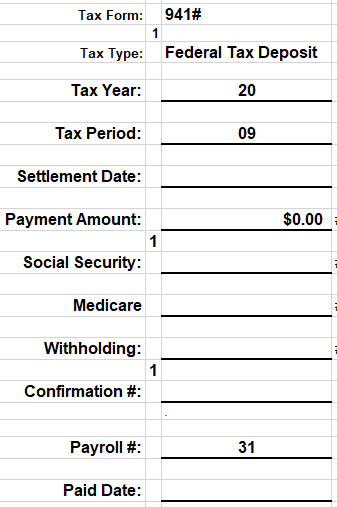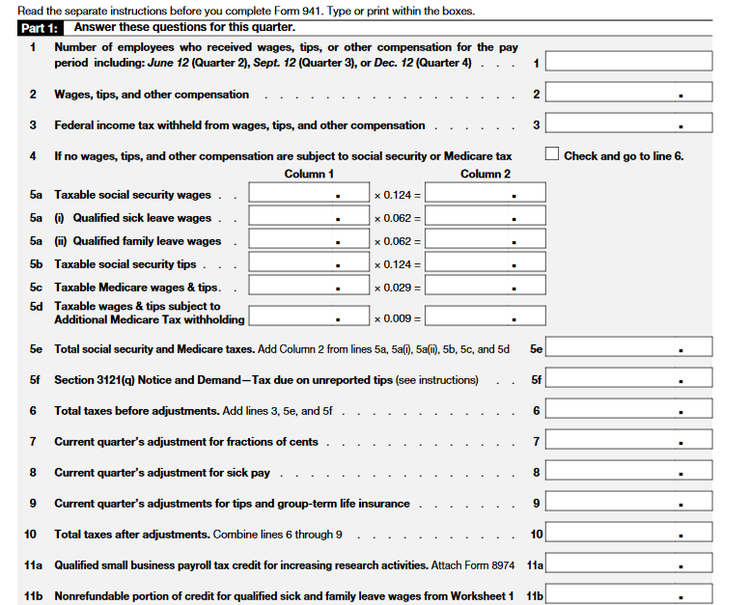How to Complete IRS Form 941
The IRS Form 941 can be a huge headache to complete each quarter. You have to run down all relevant payroll numbers and tax deduction information. You have to try to figure out how much you paid each pay period and whether you now owe money or if you’re entitled to a refund.
It can be just as difficult as filing your normal business income tax return.
It doesn’t need to be that way. In this article, I will go over the strategy that I personally use as controller for a small business to keep track of all 941 information each pay period and then report it each quarter.
All told, it takes me five minutes per week to track the information and 15 minutes each quarter to complete the form.
Overview: What is the IRS Form 941?
There are three key small business taxes that must be paid each pay period: Social Security, Medicare, and withholding. For Social Security and Medicare, the employer and employee portions must be paid. For withholding, you pay only the employee portion.
The IRS Form 941 is a quarterly report that shows the sum of each of the three payments for the quarter, as well as payroll data for employees. For unique businesses, it also includes reports of items such as tips earned by employees that may change the total amount due.
Where do employers get Form 941?
There is a new form released each year, so make sure to bookmark the IRS 941 instructions page for the form and not the actual PDF. You can find the updated 941 Form each year on that page. This applies to other IRS tax forms, as well. Make sure to complete the form on the correct year’s version.
The best scenario is to use your tax software to complete the form for you. It is a good control to find the correct IRS form and make sure it matches what your software provides.
How to fill out Form 941 to complete your small business taxes
If you don’t keep good records, completing your quarterly 941 will be a huge pain in the tuchus. Read on to learn some strategies for keeping all the information together during the quarter to make it easier on yourself come reporting time.
Step 1: Complete EFTPS worksheet each pay period
The IRS’s Electronic Federal Tax Payment System (EFTPS) is used to remit payment to the IRS. It is what you should use to pay Social Security, Medicare, and withholding taxes each pay period.
The below graphic shows a screenshot of the spreadsheet that I personally use each week to make payments to the IRS for the company where I am the controller.

My company processes payroll weekly and right now is on payroll #31 for the year. Image source: Author
Each pay period, after you’ve processed payroll, print a report of all the tax deductions for the period, including Social Security (commonly called FICA), Medicare, and withholding. Enter the amounts into their respective cells and the sum in the payment amount cell. Next, we’ll look at how to make the payment.
Step 2: Make EFTPS payments each pay period
I call the payment in each week, using the sheet as a guide. You can call 1-800-555-3453 and make payments by phone once you have set up the electronic funds transfer with your bank on the IRS website.
Call the number, enter in the 941 Form, and then the correct year and quarter. You can then report the total amount that is due that week. The IRS does not require you to break out the amounts for each category.
Once you’re done, you will get a confirmation number and settlement date (typically the next business day); it is imperative to keep these numbers recorded. The IRS is a massive organization and is prone to mistakes in its record-keeping for 941 reporting.
Employment tax payments are required to be made either semi-weekly or monthly. You can dig through a mountain of IRS mumbo jumbo to determine which you are required to do, but you’re better off just making a habit of doing the payment each pay period.
It is easier to match the taxes to the correct payroll that way and, once you get the hang of it, it shouldn’t take more than 10 minutes.
You can also make the payment online at the EFTPS website linked above. Make sure to keep track of the same numbers.
Step 3: Gather worksheets for the quarter
I number each pay period and create a separate tab in the spreadsheet for each. At the end of the quarter, it is easy to select each tab and print them all at once. This will give you the backup for your 941 filings.
Step 4: Print Form 941 with 941 Schedule B from your software
You should be able to print out the quarterly IRS tax forms for business taxes with your accounting or tax software. Make sure to print out the Schedule B and the main form.
If your software does not automatically generate the report, follow the steps after this graphic.

Most of the items on Form 941 will be left blank. Image source: Author
Complete the first two squares and 5a through 5d with information from your software or payroll provider. Add up all the worksheets from the quarter for square 3 and 5e.
Use Schedule B to enter in each payment made to show the total tax paid on the next page. This is then compared to the total tax owed.
Most of the other squares will be left blank. If you suspect that you need to fill them out, you can find specific instructions from the IRS on this page. If you run a restaurant, keep the tips data filed. You will need it when you file a Form W-3 at the end of the year.
Step 5: Check numbers and send to IRS
If you were able to generate the form with your software, compare Schedule B with your collected worksheets to ensure the correct amount was paid each week. If it was, you are not required to pay more taxes.
You can then send the completed form to the IRS, or you can file Form 941 online. The mailing address depends on your business location. Visit this page on the IRS website to find the correct address.
You can e-file the return as long as you use the IRS’s list of approved providers.
What are the deadlines for filing Form 941?
Form 941 is required to be filed by the last day of the month following the quarter. If that day is a weekend or holiday, it will be due the following business day. If you correctly deposited taxes through the EFTPS system each pay period, you get an additional ten days to do the filing.
The IRS imposes fines and interest for unpaid tax. If the EFTPS deposit for the tax is made late, the penalty starts day one at 2% and eventually climbs up to 10% of the unpaid tax.
If you file the return late and it has an unpaid tax amount, there is a 5% penalty each month, up to a maximum of 25%, and an additional 0.5% tax for each month that it is late.
The current interest rate charged on the unpaid amount, in addition to penalties, is an annual 3% rate. This seems low, but interest rates in general are at a generational low. It will rise when other rates increase.
Don’t dial 911 about your Form 941
If you stay on top of weekly EFTPS reporting and keep your worksheets, you can easily complete and mark off Form 941 from your tax checklist each quarter and move on to other IRS forms. Remember to save all backup documents for several years, just in case the IRS comes knocking.
Alert: our top-rated cash back card now has 0% intro APR until 2025
This credit card is not just good – it’s so exceptional that our experts use it personally. It features a lengthy 0% intro APR period, a cash back rate of up to 5%, and all somehow for no annual fee! Click here to read our full review for free and apply in just 2 minutes.
Our Research Expert
We're firm believers in the Golden Rule, which is why editorial opinions are ours alone and have not been previously reviewed, approved, or endorsed by included advertisers. The Ascent does not cover all offers on the market. Editorial content from The Ascent is separate from The Motley Fool editorial content and is created by a different analyst team.
Related Articles
View All Articles